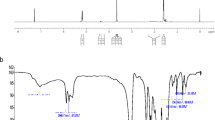Abstract
The in vitro cytotoxicity and DNA damage evaluation of biodegradable polyurethane-based micro- and nanoparticles were carried out on animal fibroblasts. For cytotoxicity measurement and primary DNA damage evaluation, MTT and Comet assays were used, respectively. Different formulations were tested to evaluate the influence of chemical composition and physicochemical characteristics of particles on cell toxicity. No inhibition of cells growth surrounding the polyurethane particles was observed. On the other hand, a decrease of cell viability was verified when the anionic surfactant sodium dodecyl sulfate (SDS) was used as droplets stabilizer of monomeric phase. Polyurethane nanoparticles stabilized with Tween 80 and Pluronic F68 caused minor cytotoxic effects. These results indicated that the surface charge plays an important role on cytotoxicity. Particles synthesized from MDI displayed a higher cytotoxicity than those synthesized from IPDI. Size and physicochemical properties of the particles may explain the higher degree of DNA damage produced by two tested formulations. In this way, a rational choice of particles’ constituents based on their cytotoxicity and genotoxicity could be very useful for conceiving biomaterials to be used as drug delivering systems.




Similar content being viewed by others
References
Andriguetti-Fröhner CR, Antonio RV, Creczynski-Pasa TB et al (2003) Cytotoxicity and potential antiviral of violacein produced by Chromobacterium violaceum. Mem Inst Oswaldo Cruz 98:843–848. doi:10.1590/S0074-02762003000600023
Do Luu HM, Hutter JC (2000) Pharmacokinetic modeling of 4, 4′-methylenedianiline released from reused polyurethane dialyzer potting materials. J Biomed Mater Res 53:276–286. doi:10.1002/(SICI)1097-4636(2000)53:3<276:AID-JBM13>3.0.CO;2-E
Durrieu V, Gandini A, Belgacem MN et al (2004) Preparation of aqueous anionic poly-(urethane-urea) dispersions: influence of the nature and proportion of the urethane groups on the dispersion and polymer properties. J Appl Polym Sci 94:700–710
Fontana G, Licciardi M, Mansueto S et al (2001) Amoxicilin-loaded polyethylcyanoacrylate nanoparticles: influence of PEG coating on the particle size, drug release rate and phagocytic uptake. Biomaterials 22:2857–2865. doi:10.1016/S0142-9612(01)00030-8
Gref R, Domb A, Quellec P et al (1995) The controlled intravenous delivery of drugs using PEG-coated sterically stabilized nanospheres. Adv Drug Deliv Rev 16:215–233. doi:10.1016/0169-409X(95)00026-4
Harush-Frenkel O, Debotton N, Benita S et al (2007) Targeting of nanoparticles to the clathrin-mediated endocytic pathway. Biochem Biophys Res Commun 353:26–32. doi:10.1016/j.bbrc.2006.11.135
Horak D, Cervinka M, Puza V (1997) Hydrogels in endovascular embolization VI Toxicity tests of poly(2-hydroxyethyl methacrylate) particles on cell cultures. Biomaterials 18:1355–1359. doi:10.1016/S0142-9612(97)00059-8
Jiang J, Oberdörster G, Biswas P (2008) Characterization of size, surface charge, and agglomeration state of nanoparticle dispersions for toxicological studies. J Nanopart Res 11:77–89. doi:10.1007/s11051-008-9446-4
Kim HW, Ahh EK, Jee BK et al (2009) Nanoparticulate-induced toxicity and related mechanism in vitro and in vivo. J Nanopart Res 11:55–65. doi:10.1007/s11051-008-9447-3
Kobayashi H, Sugiyama C, Morikawa Y et al (1995) A comparison between manual microscopic analysis and computarized image analysis in the single cell gel electrophoresis assay. MMS Commun 3:103–115
Lelah MD, Cooper SL (1986) Polyurethanes in medicine. CRC Press, Boca Raton
Lewinski N, Colvin V, Drezek R (2008) Cytotoxicity of nanoparticles. Small 4:26–49. doi:10.1002/smll.200700595
Michel R, Pasche S, Textor M et al (2005) Influence of PEG architecture on protein adsorption and conformation. Langmuir 21:12327–12332. doi:10.1021/la051726h
Midander K, Cronholm P, Karlsson HL et al (2009) Surface characteristics, copper release, and toxicity of nano- and micrometer-sized copper and copper(II) oxide particles: a cross-disciplinary study. Small 5:389–399. doi:10.1002/smll.200801220
Mossmann T (1983) Rapid colorimetric assay for cellular growth and survival: application to proliferation and cytotoxicity assays. J Immunol Methods 65:55–63
Myamae Y, Yamamoto M, Sasaki YF et al (1998) Evaluation of a tissue homogenization that isolates nuclein for the in vivo single cell gel electrophoresis (Comet) assay: a collaborative study by five laboratories. Mutat Res 418:131–140
Papageorgiou I, Brown C, Schins R et al (2007) The effect of nano- and micron-sized particles of cobalt-chromium alloy on human fibroblasts in vitro. Biomaterials 28:2946–2958. doi:10.1016/j.biomaterials.2007.02.034
Sekihashi K, Saitoh H, Saga A (2003) Effect of in vitro exposure time on comet assay results. Environ Mutagen Res 25:83–86
Sieuwerts A, Klijn JGM, Peters HA et al (1995) The MTT tetrazolium salt assay scrutinized: how to use this assay reliably to measure metabolic activity of cell cultures in vitro for the assessment of growth characteristics, IC50-values and cell survival. Eur J Clin Chem Clin Biochem 33:813–823. doi:0099-2240/99/$04.0010
Simões SI, Tapadas JM, Marques CM et al (2005) Permeabilization and solubilization of soybean phosphatidylcholine bilayer vesicles, as membrane models, by polysorbate Tween 80. Eur J Pharm Sci 26:307–317
Spiekstra SW, Dos Santos GG, Scheper RJ et al (2009) Potential method to determine irritant potency in vitro—comparison of two reconstructed epidermal culture models with different barrier competency. Toxicol In Vitro 23:349–355. doi:10.1016/j.tiv.2008.12.010
Tice RR, Agurell E, Anderson D et al (2000) Single cell gel/Comet assay: guidelines for in vitro genetic toxicology testing. Environ Mol Mutagen 35:206–221
Verma A, Uzun O, Hu Y et al (2008) Surface-structure-regulated cell-membrane penetration by monolayer-protected nanoparticles. Nat Mater 7:588–595. doi:10.1038/nmat2202
Walum E, Strenberg K, Jenssen D (1990) Understanding cell toxicology: principles and practice. Ellis Howood, New York
Yao C, Acosta D (1992) Surfactant cytotoxicity potential evaluated with primary cultures of ocular tissues: a method for the culture of rabbit conjunctival epithelial cells and initial cytotoxicity studies. Toxicol Mech Methods 2:199–218. doi:10.3109/15376519209066106
Yin H, Too HP, Chow GM (2005) The effects of particle size and surface coating on the cytotoxicity of nickel ferrite. Biomaterials 26:5818–5826. doi:10.1016/j.biomaterials.2005.02.036
Zanetti-Ramos BG, Soldi V, Lemos-Senna E et al (2005) Use of natural monomer in the synthesis of nano- and microparticles of polyurethane by suspension-polyaddition technique. Macromol Symp 229:234–245. doi:10.1002/masy.200551129
Zanetti-Ramos BG, Lemos-Senna E, Soldi V et al (2006) Polyurethane nanoparticles from a natural polyol via miniemulsion technique. Polymer 47:8080–8087. doi:10.1016/j.msec.2007.04.041
Acknowledgements
The Brazilian authors thank Capes/MEC and CNPq/MCT (Brazil) for their research fellowships.
Author information
Authors and Affiliations
Corresponding author
Rights and permissions
About this article
Cite this article
Caon, T., Zanetti-Ramos, B.G., Lemos-Senna, E. et al. Evaluation of DNA damage and cytotoxicity of polyurethane-based nano- and microparticles as promising biomaterials for drug delivery systems. J Nanopart Res 12, 1655–1665 (2010). https://doi.org/10.1007/s11051-009-9828-2
Received:
Accepted:
Published:
Issue Date:
DOI: https://doi.org/10.1007/s11051-009-9828-2




